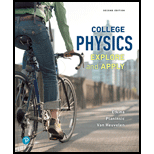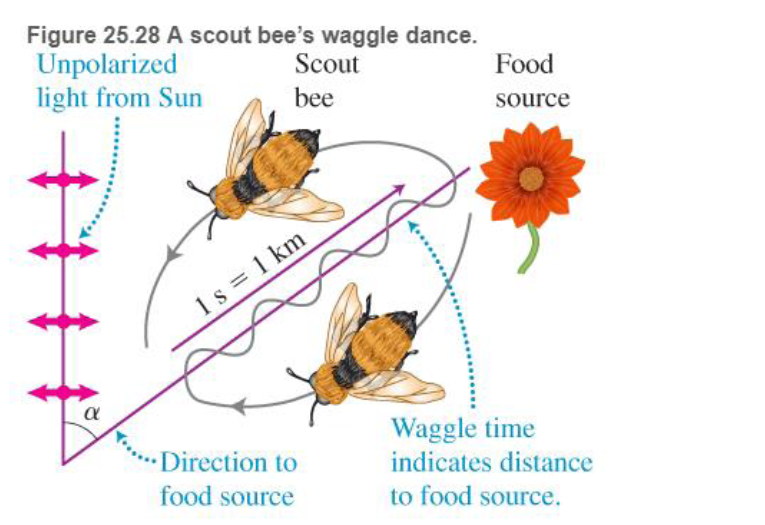
Concept explainers
BIO Amazing honeybees The survival of a bee colony depends on the ability of bee scouts to locate food and to convey that information to the hive. After finding a promising food source, a honeybee scout returns to the hive and uses a waggle dance to tell its worker sisters the direction and distance to the food.
Recall that light coming directly from the Sun is unpolarized. Bees use the direction of the Sun as a reference for their travel. In the hive, the scout bee's waggle dance is in the shape of a flat figure eight (Figure 25.28). The upward direction in the vertical hive represents the direction toward the Sun. The middle line of the scout’s figure eight points in the direction of the food relative to the direction of the Sun. I hus a

Bees know the direction to the Sun because
a. direct sunlight is linearly polarized.
b. direct sunlight is unpolarized.
c. they detect infrared
d. a and c.
e. b and c.
Want to see the full answer?
Check out a sample textbook solution
Chapter 25 Solutions
College Physics
Additional Science Textbook Solutions
University Physics Volume 2
Physics (5th Edition)
The Cosmic Perspective (8th Edition)
College Physics
Modern Physics
Physics for Scientists and Engineers: A Strategic Approach, Vol. 1 (Chs 1-21) (4th Edition)
- Lunar astronauts placed a reflector on the Moon's Surface, off which a laser beam is periodically reflected. The distance to the Moon is calculated from the round-trip time. (a) To what accuracy in meters can the distance to the Moon be determined, if this time can be measured to 0.100 ns? (b) What percent accuracy is this, given the average distance to the Moon is 3.84108m ?arrow_forwardSuppose you are facing a tall makeup mirror on a vertical wall. Fluorescent tubes framing the mirror carry a clockwise electric current. (i) What is the direction of the magnetic field created by that current at the center of the mirror? (a) left (b) right (c) horizontally toward you (d) horizontally away from you (e) no direction because the field has zero magnitude (ii) What is the direction of the field the current creates at a point on the wall outside the frame to the right? Choose from the same possibilities as in part (i).arrow_forwardConstruct Your Own Problem Consider a space sail such as mentioned in Example 29.5 Construct a problem in which you calculate the light pressure on the sail in N/m2 produced by reflecting sunlight. Also calculate the force that could be produced and how much effect that would have on a spacecraft. Among the things to be considered are the intensity of sunlight, its average wavelength, the number of photons per square meter this implies, the area of the space sail, and the mass of the system being accelerated.arrow_forward
- 8.) Please refer to the diagram on page 41 of your course packet for the remaining questions. It's a sketch of the Bainbridge mass spectrometer, used to identify the masses of atomic isotopes. The velocity selector inside the central rectangle has a magnetic field pointing out of the paper with a field strength, B, of 0.380 T and an electric field of strength, E, of 122,000 N/C. With what speed will ions pass through the slit S2? Express you answer in exponential notation in m/s. 9.) A velocity selector, as in the previous question, works to select ions of a particular speed because A.) the electric and magnetic fields both depend on the speed of the ions. B.) neither the electric nor the magnetic fields depend on the speed of the ions. C.) the magnetic force on an ion depends on its speed, but the electric force does not. D.) the electric force on an ion depends on its speed, but the magnetic force does not.arrow_forwardPhysics Polarization: Write down the equations of an unpolarized E field before it hits a linear polarizer that is polarized in the x-direction. What are the E field equations after the linear polarization? I'm having extreme difficulty on this problem, need some guidance.arrow_forwardThoroughly explain why electromagnetic radiation can be modeled as both a wave and a particle. Provide an example for each model, both wave and particle.arrow_forward
- Describe how one could make a laser beam visible in air. I need a brief answer to this question. 3-5 sentences. Thanks!arrow_forward4. Light waves are electromagnetic and not mechanical. What does this have to do with the fact that ligh can travel through outer space? 5. Define the following: wavelength, frequency, speed of light, energy of light, and wavenumber.arrow_forward6.What is the relationship between wavelength and frequency for electromagnetic radiation? A.The wavelength and frequency are directly related to each other. B.The wavelength can be used to determine the frequency, but frequency cannot be used to determine wavelength. C.The wavelength and frequency are equal to each other. D.The wavelength and frequency are inversely related to each other.arrow_forward
- The radar system at an airport broadcasts 22 GHz microwaves with 300 kW of power. An approaching airplane with a 62 m2 cross section is 66 km away. Assume that the radar broadcasts uniformly in all directions and that the airplane scatters microwaves uniformly in all directions. What is the electric field strength of the microwave signal received back at the airport 440 μs later?arrow_forwardLaser vision correction often uses an excimer laser that produces 193-nm electromagnetic radiation. This wavelength is extremer strongly absorbed by the cornea and athletes it in a manner that reshapes the cornea to correct vision detects. Explain how the strong absorption helps concentrate the energy in a thin layer and thus give greater accuracy in shaping the cornea. Also explain how this strong absorption limits damage to the lens and retina of the eye.arrow_forwardCombing your hair leads to excess electrons on the comb. How fast would you have to move the comb up and down to produce red light?arrow_forward
 Physics for Scientists and Engineers, Technology ...PhysicsISBN:9781305116399Author:Raymond A. Serway, John W. JewettPublisher:Cengage Learning
Physics for Scientists and Engineers, Technology ...PhysicsISBN:9781305116399Author:Raymond A. Serway, John W. JewettPublisher:Cengage Learning Glencoe Physics: Principles and Problems, Student...PhysicsISBN:9780078807213Author:Paul W. ZitzewitzPublisher:Glencoe/McGraw-Hill
Glencoe Physics: Principles and Problems, Student...PhysicsISBN:9780078807213Author:Paul W. ZitzewitzPublisher:Glencoe/McGraw-Hill
 Principles of Physics: A Calculus-Based TextPhysicsISBN:9781133104261Author:Raymond A. Serway, John W. JewettPublisher:Cengage Learning
Principles of Physics: A Calculus-Based TextPhysicsISBN:9781133104261Author:Raymond A. Serway, John W. JewettPublisher:Cengage Learning College PhysicsPhysicsISBN:9781938168000Author:Paul Peter Urone, Roger HinrichsPublisher:OpenStax College
College PhysicsPhysicsISBN:9781938168000Author:Paul Peter Urone, Roger HinrichsPublisher:OpenStax College Physics for Scientists and Engineers: Foundations...PhysicsISBN:9781133939146Author:Katz, Debora M.Publisher:Cengage Learning
Physics for Scientists and Engineers: Foundations...PhysicsISBN:9781133939146Author:Katz, Debora M.Publisher:Cengage Learning





